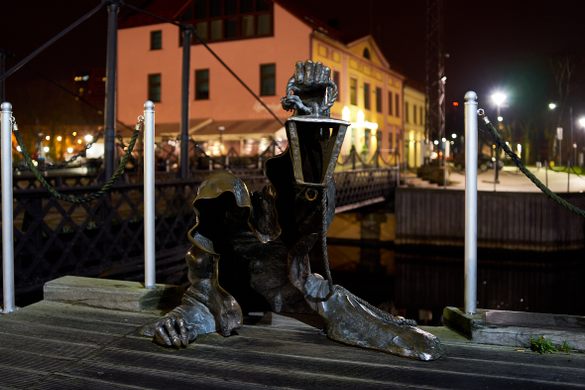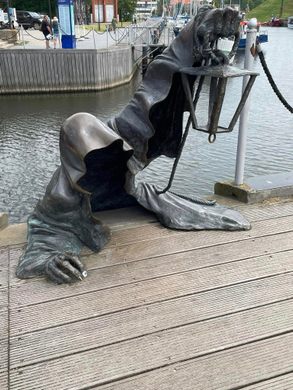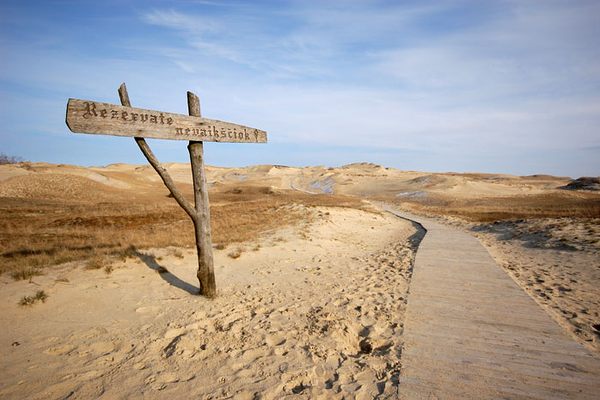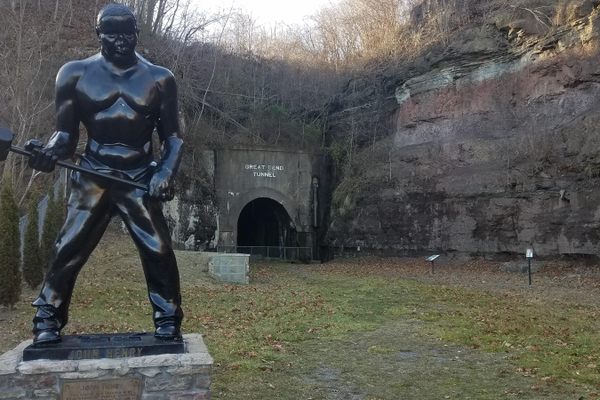AO Edited
Juodasis Vaiduoklis (The Black Ghost)
A creepy statue of a hooded ghost hauls itself up from the water in a historic Lithuanian city.
Klaipėda (formerly Memel) is a historic and relatively tranquil port city on Lithuania’s Baltic coast. Since it was first mentioned in historic records in 1252, it has variously been governed by the Teutonic Knights, the Kingdom of Prussia, the German Empire, and the Soviet Red Army.
Thanks to its historic role as one of the foremost ice-free ports in the Eastern Baltic, Klaipėda has long been an important maritime location, with large shipyards and fishing ports. In more recent years, cruise ships have been coming to Klaipėda, their passengers coming ashore to enjoy the nearby white sand beaches and the city’s numerous theaters, museums, historic sites, and traditional breweries.
Arguably the most incongruous sight in the city’s old town, at least for newly arrived tourists, is located along the peaceful waterfront. Here, a hooded, wraithlike figure, not dissimilar to the Nazgûl from The Lord of the Rings, clambers up from the water, holding aloft a lantern in its gnarled hand.
The bronze sculpture, known as “Juodasis Vaiduoklis” (“The Black Ghost”) has been terrifying children since 2010. Sculpted by Svajunas Jurkus and Sergejus Plotnikovas, the figure is 7.8 feet in height, with about half below the level of the waterfront walkway and half above. Apart from the ghost’s hands, the hooded robe is empty inside, creating a strangely expressive spectral appearance despite the lack of any facial features.
For many new arrivals, the main question regarding this creepy sculpture is: Why? Well, it’s all tied to a local legend that isn’t quite as terrifying as you would imagine. The legend dates back to 1595, when Hans von Heidi, one of the guards at Klaipėda Castle, was doing his nightly rounds near the harbor.
From out of nowhere, a hooded figure appeared near the water’s edge. Rather than attack the startled guard, it asked him how the city’s supplies of grain and timber were holding out. Von Heidi informed the ghost that the city had sufficient supplies, but the ghost warned him it would not be enough. At that point, the apparition vanished.
Back in the good old days, of course, people were inclined to believe the words of ghosts, witches, goblins, and giants. And so Hans von Heidi dutifully informed his superiors of his ghostly encounter, and the city set about increasing its supplies of timber and grain. Then followed a bleak few years of hunger and shortage, which the people of Klaipėda only survived because of the ghost’s warning.
So rather than being a twisted tribute to some nefarious Nazgûl-like wraith, the sculpture of the Black Ghost pays tribute to Klaipėda’s spectral savior: a Casper of sorts, just far more frightening.
Know Before You Go
The Black Ghost sculpture is located near the ruins of Klaipėda Castle along the castle marina, just past the swing bridge and near the Old Mill Hotel. Klaipėda is located in western Lithuania along the Baltic Sea coast. At night the sculpture is illuminated internally with a green glow, making it a little more creepy than normal.






















Follow us on Twitter to get the latest on the world's hidden wonders.
Like us on Facebook to get the latest on the world's hidden wonders.
Follow us on Twitter Like us on Facebook